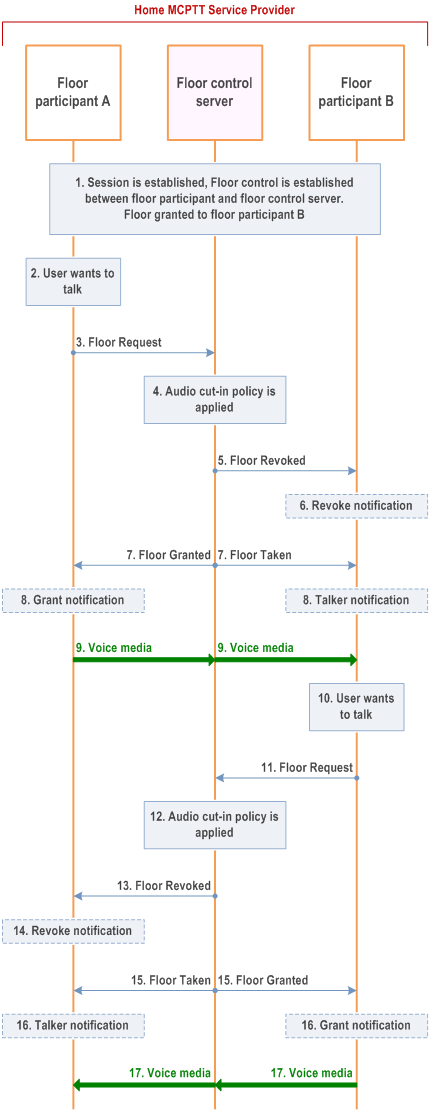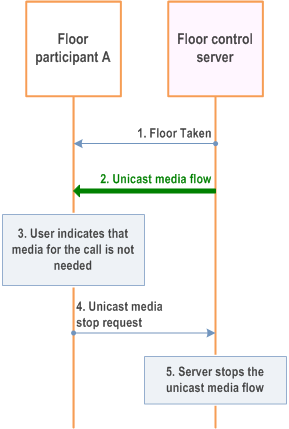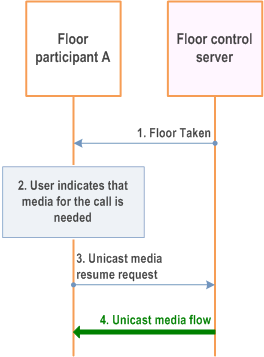Content for TS 23.379 Word version: 19.3.0
1…
7…
7.4…
10…
10.5…
10.6…
10.6.2.2.13…
10.6.2.2.24…
10.6.2.3…
10.6.2.3.1.2…
10.6.2.3.2…
10.6.2.4…
10.6.2.4.3…
10.6.2.5…
10.6.2.5.2.3…
10.6.2.6…
10.6.2.6.2…
10.6.2.7…
10.6.2.10…
10.6.3…
10.7…
10.7.2.2…
10.7.2.3…
10.7.3…
10.7.4…
10.7.5…
10.7.5.2.3a…
10.7.6…
10.7.6.2.3…
10.9…
10.9.1.3…
10.9.1.3.2…
10.9.1.3.3…
10.9.1.4…
10.9.1.5…
10.9.2…
10.9.2.6…
10.10…
10.12…
10.14…
10.15…
10.19…
10.19.2.11…
10.19.3…
10.19.3.1.4…
10.19.3.2…
10.19.3.2.4…
10.19.3.2.6…
A…
A.4…
B…
10.9.1.5 Floor control for audio cut-in enabled group
10.9.1.6 Unicast media stop and resume requests
...
...
10.9.1.5 Floor control for audio cut-in enabled group p. 188
Figure 10.9.1.5-1 shows the procedure for audio cut-in for the session already established between the floor participants from same MCPTT service provider. Floor participants may request the floor while Floor Participant B is transmitting voice media. Floor control server grants floor immediately to the floor request received.
Pre-conditions:
- The floor control server has been configured to support audio cut-in.
- It is assumed that the floor has been granted to floor participant B and floor participant B is transmitting voice media. There are several other floor participants (including floor participant A).

Step 1.
Floor participant B has been given floor and is transmitting voice media.
Step 2.
Floor participant A wants to send voice media over the session.
Step 3.
Floor participant A sends a floor request message to the floor control server.
Step 4.
The floor control server applies the audio cut-in policy with floor queue disabled i.e., floor is immediately granted to the floor participant A, and revoked from floor participant B.
Step 5.
The floor control server sends a floor revoked message to floor participant B stopping the voice media transmission from floor participant B.
Step 6.
The user of floor participant B may be notified that the floor is revoked.
Step 7.
The Floor control server sends a floor granted message to floor participant A, and sends a floor taken message to floor participant B with information of who is granted the floor. The floor control server may limit the time a user talks (holds the floor).
Step 8.
The user of floor participant A may be notified that he is granted the floor. Similarly, the user of floor participant B may be notified who is granted the floor.
Step 9.
Floor participant A starts sending voice media over the session established.
Step 10.
Now floor participant B may want the floor to start sending voice media.
Step 11.
Floor participant B sends a floor request message to floor control server.
Step 12.
The floor control server applies the audio cut-in policy with floor queue disabled.
Step 13.
The floor control server sends a floor revoked message to floor participant A stopping the voice media transmission from floor participant A.
Step 14.
The user of floor participant A may be notified that the floor is revoked.
Step 15.
The Floor control server sends a floor granted message to floor participant B, and sends a floor taken message to floor participant A with information of who is granted the floor. The floor control server may limit the time a user talks (holds the floor).
Step 16.
The user of floor participant B may be notified that he is granted the floor. Similarly, the user of floor participant A may be notified who is granted the floor.
Step 17.
Floor participant B starts sending voice media over the session established.
10.9.1.6 Unicast media stop and resume requests |R15| p. 190
Figure 10.9.1.6-1 shows the procedure for a floor participant to indicate to the floor control server that the unicast media flow of an active MCPTT group call can be stopped.
Pre-condition:
- An MCPTT session is established between MCPTT client A and MCPTT server for an MCPTT group call. Other participants to the call are not shown in the Figure for simplicity.
- The floor control is established between the floor participant and the floor control server.

Step 1.
Figure 10.9.1.6-2 shows the procedure for a floor participant to request from the floor control server that the unicast media flow of an active MCPTT group call be restarted.
Pre-condition:
Another floor participant has requested and has been granted the floor. The floor control server sends a floor taken message to floor participant A. The floor taken message may include an identifier of the associated media flow.
Step 2.
Floor control server sends the voice media flow to floor participant A over unicast.
Step 3.
Floor participant A gets the information, e.g. from the user, that media for the call is not needed.
Step 4.
Floor participant A sends a unicast media stop request to floor control server, identifying the media flow to be stopped.
Step 5.
Floor control server stops sending that unicast media flow to floor participant A. Associated bearer resources may be de-allocated by the MCPTT server.
- An MCPTT session is established between MCPTT client A and MCPTT server for an MCPTT group call. Other participants to the call are not shown in the Figure for simplicity
- The floor control is established between the floor participant and the floor control server.
- Floor participant A has previously indicated to the floor control server that unicast media flow for that call should be stopped, using the procedure described in Figure 10.9.1.6-1.

Step 1.
Another floor participant has requested and has been granted the floor. The floor control server sends a floor taken message to floor participant A. The floor taken message may include an identifier of the associated media flow.
Step 2.
Floor participant A gets the information, e.g. from the user, that media for the call is needed again.
Step 3.
Floor participant A sends a unicast media resume request to floor control server, identifying the media flow to be re-started.
Step 4.
Floor control server starts sending that unicast media flow to floor participant A. This may need new bearer resources to be allocated.